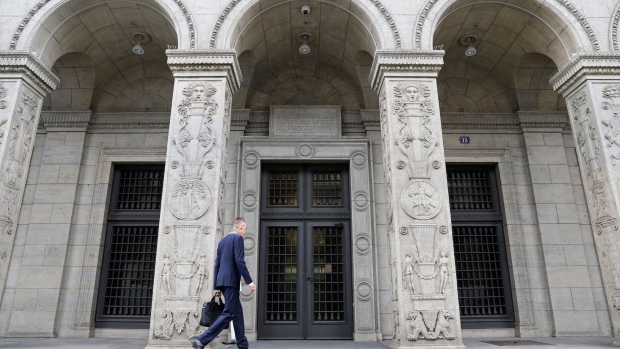Nov 2, 2023
Swiss Digital Wholesale Franc to Kick Off Next Month, SNB Says
, Bloomberg News

(Bloomberg) -- The Swiss National Bank will launch the pilot phase of its planned digital wholesale franc in December.
The project — in collaboration with six commercial banks from Switzerland and Germany and Swiss stock exchange provider SIX — will entail issuing a digital Swiss franc on a blockchain using distributed-ledger technology, or DLT, Switzerland’s monetary authority said in a statement Thursday.
As a majority of central banks around the world are working on digital currencies, the tokenized form of central-bank money would be the first so-called wholesale CBDC which goes live in the world, according to the Atlantic Council. It’s supposed to facilitate transactions between financial institutions and the central bank. Consumers won’t be able to hold the tokens.
“With this pilot project, we are now, for the first time, making it possible to securely and efficiently settle transactions with tokenized assets on a regulated and productive DLT platform using real wholesale CBDC,” SNB President Thomas Jordan said. “We are proud of our internationally pioneering role in this area as we carry out this innovative project together with SIX and the participating banks.”
Those banks are Banque Cantonale Vaudoise, Basler Kantonalbank, Germany’s Commerzbank, Hypothekarbank Lenzburg, UBS and Zuercher Kantonalbank, the SNB said. The pilot, which kicks off on Dec. 1, is scheduled to run until June 2024.
Participating banks must have access to the Swiss Interbank Clearing system and SNB’s sight deposits, as well as being members of SIX’s Swiss Digital Exchange, the central bank said. For the pilot phase, participation is limited to the six announced lenders.
“The objective of the pilot is to test, in a live production environment, the settlement of primary and secondary market transactions in wCBDC,” SIX said in a separate statement. “Participating banks will be able to issue digital Swiss franc bonds, which will be settled against wCBDC on a delivery-versus-payment basis.”
The project will also extend to the settlement of repo transactions, according to SIX.
Wholesale vs. Retail
The SNB had announced to launch a digital currency in March as part of a limited-time test. It said then that it’s not yet decided whether the digital franc will be kept after the test period — a view that was reaffirmed in Thursday’s statement.
A Bank for International Settlements study found earlier this year that there could be as many as 24 CBDCs in circulation by 2030, but most research focuses on consumer applications. As opposed to the SNB’s digital franc for banks, for example the European Central Bank’s digital euro project focuses on everyday transactions.
“We envisage a digital euro as a digital form of cash that can be used for all digital payments, free of charge, and that meets the highest privacy standards,” ECB President Christine Lagarde said when the project moved into a preparation phase last month. “It would coexist alongside physical cash, which will always be available, leaving no one behind.”
The SNB has been skeptical of issuing such a “retail” CBDC, citing limited advantages and risks of bank runs.
“Cashless payment transactions in Switzerland are already reliable, secure and work efficiently,” the central bank said on Thursday in an email. “Access to digital central bank money for all households and companies would therefore hardly yield any advantages.”
(Updates with further details and SIX statement starting in second paragraph)
©2023 Bloomberg L.P.





